An American Artist and a Scottish Scientist in Juniper Green
AUDUBON AND MACGILLIVRAY'S ORNITHOLOGICAL WALK
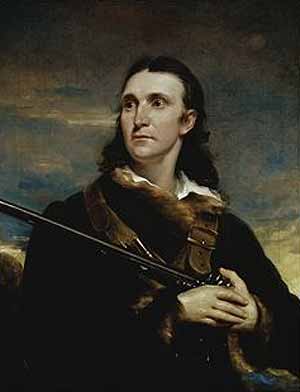
© White House Historical Association
John James Audubon, John Syme 1826
On the first of May 1839 two eminent men, a Scot and an American with something to celebrate, took a walk from Glencorse through the Pentlands to Currie and back to Edinburgh along the valley of the Water of Leith. The two men were the famous American ornithologist, John James Audubon, widely regarded as the greatest bird painter of all time, and his friend and collaborator William MacGillivray, conservator of the Natural History Museum at the Royal College of Surgeons, the most notable ornithologist in Scotland and author of A History of British Birds, and himself a talented artist. They were accompanied by John MacGillivray, William's eldest son, who was 17 years old at the time. The cause for celebration was the completion, after nine years of work, of Audubon's five volume Ornithological Biographies: MacGillivray was the co-author, assisting Audubon with literary presentation and, in particular, giving the book scientific weight and authority. To mark the completion of this mammoth task and possibly also as a fitting end to Audubon's fifth and last visit to Edinburgh, they went on a birding trip into the Pentland Hills, taking in the Juniper Green stretch of the Water of Leith between stops for refreshment in public houses in Currie and Colinton.
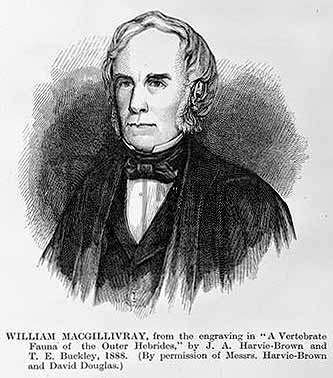
© The Natural History Museum, London
William MacGillivray
Today's birder takes binoculars, telescope and camera to enhance his or her enjoyment of wild nature, observing and recording. The nineteenth century naturalist went out, not just to be inspired by the beauties of nature and to record what he had seen, but mainly to collect specimens for research, or even as a memento of the expedition. If he was an ornithologist, he took a gun. It is hard for us in these conservation minded days to understand how people like Audubon and MacGillivray who clearly derived so much pleasure from watching birds and listening to their songs, and who were fascinated by their behaviour, should also be so keen to shoot them dead. They often killed many more than they needed for scientific or artistic purposes, and indeed would boast of their prowess as sportsmen when they managed to bag large numbers with one or two shots. They had been frustrated in the Pentlands by the ban on guns on the property of the Water Company and of Mr Robertson, having twice been warned by local shepherds not to shoot anything there. There seem to have been no such restrictions along the Water of Leith, where, despite an intake of whisky in Currie, the aim of the three remained unerring, with unhappy results for the area's songbirds.
We owe our account of the Mayday walk to MacGillivray who, in volume 2 of his History of British Birds, gives us his record of the excursion in the form of a conversation between himself, his son John, and Audubon. He apparently felt it desirable to lend their friendly chat the weight of serious discourse by presenting it in an elevated and artificial English, but there is little doubt that it represents the essence of what was said. Perhaps to remind us further of their scientific credentials, or perhaps also to provide a modest anonymity, he adopts latinate names for himself and John. He, William, becomes "Ornithologus", while John is "Physiophilus". The famous Audubon is allowed his own name. However, in keeping with the literary conventions of the time, when the trio meet shepherds and a miller, demotic speech is good enough for such uneducated folk. The excerpts below from MacGillivray's book begin with their departure from the inn in Currie where they have consumed porter, whisky and water, soup, oat bread, cheese and cold meat.
Aud: Well now, having refreshed ourselves, let us march.
Orn: It is a sweet spot, and must be very beautiful in summer, when all those trees and bushes are clothed with foliage. The golden catkins of the willow margin the clear brook, the pure light green of the larches enlivens that steep slope, and here, amidst the grass of this bank, peep forth the Dog Violet, the Pilewort [Lesser Celandine] and the barren Strawberry, while the Butterburs stand sturdily forth, their pink florets attractive of the black-and-yellow bees, which eagerly pump out their sweet juices. Many Willow Wrens warble at intervals on the trees; but I hear no other summer bird. The gentle Mavis mingles its sweet notes with the louder and more lively song of the Blackbird. There, Physiophilus, get us a pair of Willow Wrens.
The willows, larches and flowering plants can still be found on the sides of the valley. Bumble bees may not now be as common as they were in 1839 and recently willow warblers appear to be in decline, as is the mavis or song thrush. Could they see this stretch of the Water of Leith today, the three naturalists would certainly be surprised by the ubiquitous giant hogweed.
We learn below the fate of the luckless Willow Wrens: that they were added to the day's bag of specimens, hardly a surprise since all three men prided themselves on their excellent marksmanship.
This is followed by a discussion of the merits of the songs of different American birds. The walkers then encounter a miller at his mill, presumably to be seen as typical of the mills lying between Currie and Colinton, though the bridge referred to by the miller is probably Mutter's Bridge which would identify the grain mill at East Mills as the actual location, lying as it does "just here below the bridge". The miller and his family apparently supplemented their income from the mill by farming in a small way, keeping a few cattle and domestic fowl.
The miller assumes that three gentlemen with guns must be looking for trophies for the display cabinet. As for the birds the miller refers to, the kingfisher is still seen regularly today. The "Water Crows" are a bit of a puzzle; one of the names for the dipper in the Lothians was 'water crow'. However, the miller would have seen them all year round. Dippers hold their territories throughout the year and would have been a familiar sight in every season, as they are today. They nest under bridges and in other manmade constructions near or over the water and certainly would have used sites in the stonework of the mills. It is just possible that the miller was referring to cormorants, many of which migrate inland in autumn for the winter. A common name for the cormorant was 'sea crow' and cormorants are today occasional visitors to the river. It is possible that in the past cormorants were more common in cold weather on the Water of Leith, before the building of all the Pentland reservoirs which now attract them, and when the weirs were in good repair, resulting in many more wide pools on the river. It may be that the miller refers to these birds, but on the other hand, MacGillivray, in The History of British Birds, says that in winter the dipper haunts mill weirs, besides which he gives 'water crow' as one of its names. Perhaps the miller had more leisure to observe birds in the winter months and was too busy at other times of year to pay them much attention. On balance it seems likely that he was indeed referring to dippers.
Miller: A fine day, gentlemen; you are looking for birds, I suppose, for stuffing.
Orn: Not exactly for that purpose. What birds do you commonly see here, any Kingfishers?
Miller: Yes, very often, just here below the bridge, and in autumn and winter Water Crows. It's a fine place for birds; the water-side's just full o' them in summer.
Aud: Two splendid short-horned oxen fattening in the yard, two Orkney queys [heifers], and a fine Newfoundland dog. Is it a flour mill you have? I daresay you are very comfortable here.
Miller: Well enough. We grind oats and barley, have plenty to eat, something to drink, good air, and room enough to breathe.
Taking a fashionably Romantic view of rural life, and no doubt with some truth, MacGillivray favourably compares the idyllic existence of the domestic animals and of the miller in Juniper Green with the squalid conditions of livestock and workers in the city. Note the allusion in the quotation below to the contemporary passion for self-improvement and the thirst for education among the city's poor which took them to lectures and reading rooms.
Orn: How clean and happy-looking the ducks and drakes, and cocks and hens, and turkeys are, compared with the starved and draggled creatures about the towns; the very sparrows are fatter and more ruddy; the rustics plump and rosy and cleanly, compared with the poor mechanics of the city, sallow and dirty by necessity, and I must say often rude. For my part, let them talk of their scientific associations, reading rooms, and superior knowledge and civilization, I think the parish church the best lecture-room, and the fields the best reading-room. I maintain that no mechanic in Edinburgh will match in real knowledge of nature a shepherd from Yarrow Braes or Tweedsmuir.
Aud: I agree perfectly with you; but let us be off. Good evening!
After they have left the miller, John appears with the two willow warblers he has shot, having lost a blackcap in the bushes. Blackcaps still appear along the valley every spring, their rich and varied song, no longer abruptly halted by gunfire, providing one of the pleasures of a May ramble along the old railway line in 2007. Audubon's admiration of a fine male yellowhammer is enough to seal its fate, illustrating what seems to us the extraordinary contradiction between the naturalists' love of birds and their desire to shoot them. Certainly the bird artist needed specimens in every stage of plumage to try to represent each species as accurately as possible, while scientists like MacGillivray and his son wanted corpses for dissection. Nevertheless, their pride in their ability to pick off such tiny targets seems often to have led to a needless slaughter incomprehensible to a twenty first century sensibility. Yellowhammers, common in the district until comparatively recently, are now rarely seen, victims perhaps of changes in farming practice, which leads to the reflection that we in the present day are killing off wildlife at an unprecedented rate and probably should not be over critical of early nineteenth century sportsmen who, like us, did sometimes reflect on the impact they were having. Audubon himself was very conscious that his countrymen's depredations might lead to the extermination of the buffalo herds and of other once abundant animals, and on the Pentland walk he did restrain John MacGillivray from shooting a lapwing on the grounds that it might have young which would starve if it were killed.
Phys: Here are two Willow Wrens. I shot what I thought a Blackcap, but it fell into a thicket of sloes and brambles, and I could not find it.
Orn: Now, take the gun, Mr Audubon, and shoot me a bird or two to be kept as memorials of this day's excursion, that, when you are basking in the warmth of your American sunshine, under some flower-clad Magnolia, listening to the notes of the Mocking Bird, and enjoying the repose so sweet after protracted labours like yours, I may call to mind the many happy days we have spent together in cold Scotland.
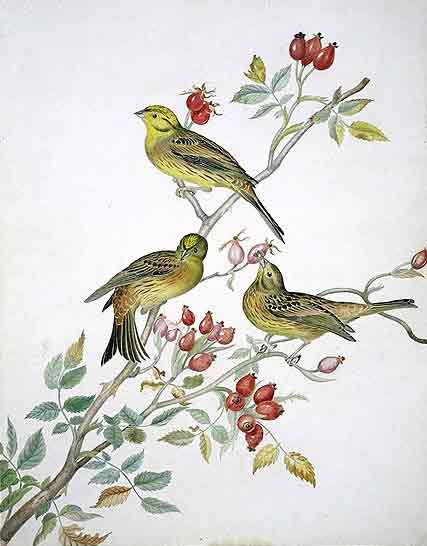
© The Natural History Museum, London
Yellow Bunting by William MacGillivray
Aud: With good will. There is a lovely male Yellow Bunting on the very tip of that fir- tree. Now for it. Come, not amiss yet! The first shot I have fired since I came to England last.
Phys:. Here is Colinton. Shall we go by the road, or through the woods?
Orn: Take the woods by all means. But, let us first quench our thirst. Here is the public house.
Aud: With all my heart. Your Scotch whisky is excellent.
There were fourteen pubs in Colinton parish alone in 1845, and almost certainly a similar number just six years earlier. It might however be possible to identify the providers of the excellent Scotch in Currie and Colinton. If they still exist, they could take pride in their association with Audubon who obviously appreciated their comforts and the quality of their whisky. The friends continued their walk through the Dell to Slateford where they remarked on the number of children: "as full of children as Currie was".
Audubon returned to America in July 1839. He had found in Scotland the success and recognition that had not been accorded him initially in his own country, to say nothing of the skilled Edinburgh engravers who could do justice to his paintings by making the first reproductions for his great work, The Birds of America. Unfortunately, of the original Scottish subscribers to The Birds of America, only Glasgow University has held on to its folio at the Hunterian Museum. Edinburgh University sold its copy in 1992 in New York for £2.3 million, thus severing the last link with the city that began its publication. Later in life Audubon won the fame he deserved in his native land, and today the National Audubon Society is America's leading ornithological conservation body, while his artistic achievements are recognised with regular exhibitions worldwide. As with so many artists who made little money during their lifetimes, Audubon's works now fetch enormous sums.
In 1841 MacGillivray senior, a typical lad of parts, illegitimate and from a crofting background in the Outer Hebrides, became professor of Natural History at Marischal College, Aberdeen. He died in 1852, the year in which he completed the fifth volume of his life's work, A History of British Birds. Always beset by money worries, and with ten children to bring up, MacGillivray was unable to pursue fame and success with the single-mindedness that characterised his friend Audubon. His bird paintings, though competent, lack the animation and vigour of Audubon's work. In this connection, it is interesting to compare his picture of peregrine falcons, based on a bird shot in the Pentlands, with Audubon's treatment of the same subject. MacGillivray's two birds are static, stiffly posed on a pillar of rock and gazing into an unseen distance, looking like stuffed specimens: Audubon's are alive and full of movement, squabbling, one with open threatening bloodied beak, the other with wings half-raised, over a teal and a gadwall they have killed. One of the ducks is already partly plucked, its raw flesh exposed. A feather blows away in the wind. The painting captures the ferocity of the predators as well as their streamlined grace and the dramatic action of the kill.
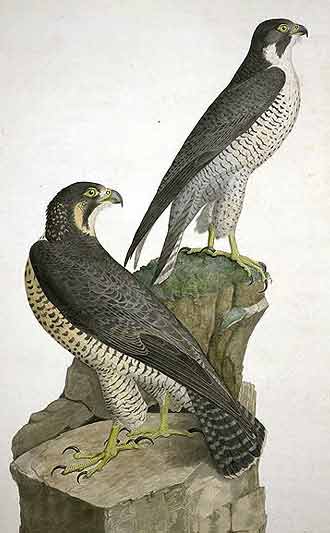
© The Natural History Museum, London
Peregrine Falcon by William MacGillivray
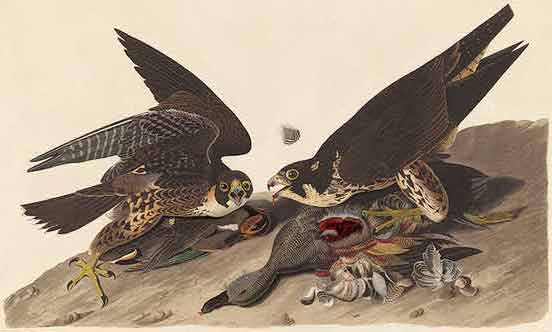
© The Natural History Museum, London
Peregrine Falcon by John James Audubon
Although one must concede his second place as a bird artist, nevertheless MacGillivray's great achievements as writer, scientist, artist and teacher, his role in the development of the museums of Edinburgh University and the Royal College of Surgeons, and his reputation as the father of British ornithology, seldom receive the prominence in his homeland that they deserve. John MacGillivray, the young "Physiophilus" of the walk, also became a distinguished scientist, going on a number of expeditions as official naturalist to Australia, where he eventually settled.
A fascinating footnote in the history of Juniper Green, the visit of these three men to our stretch of our river sheds some light on the attitudes of the day to nature, science and the urbanisation of society, as well as on the thirst for knowledge which drove the immediate heirs of the Scottish Enlightenment and made Edinburgh in particular such a powerhouse of ideas, innovation and achievement, where talent could be fostered and opportunities seized. It also provides another little piece of the jigsaw which illustrates the varied history of our village and, in the context of the wider worlds of art and science, adds life to its colourful past.
Bibliography:
Balfour, Rev Lewis, 'Parish of Colinton', The Statistical Account of Edinburghshire, (Edinburgh: William Blackwood and Sons, 1845)
Chalmers, John, Audubon in Edinburgh and His Scottish Associates, (Edinburgh: NMS Publishing, 2003)
Cramp, Stanley, and others, eds, Handbook of the Birds of Europe, the Middle East and North Africa, vol 1, 3rd edn, (Oxford: Oxford University Press, 1980) and vol 5, (Oxford: Oxford University Press, 1988)
Darwin, Tess, The Scots Herbal, (Edinburgh: Mercat Press 1996)
Hull, Robin, Scottish Birds, Culture and Tradition, (Edinburgh: Mercat Press, 2003)
Keay, John and Keay, Julia, eds, Collins Encyclopaedia of Scotland, (London: Harper Collins, 1994)
MacGillivray, William, The History of British Birds Vol.2, (London: Scott, Webster & Geary, 1839)
